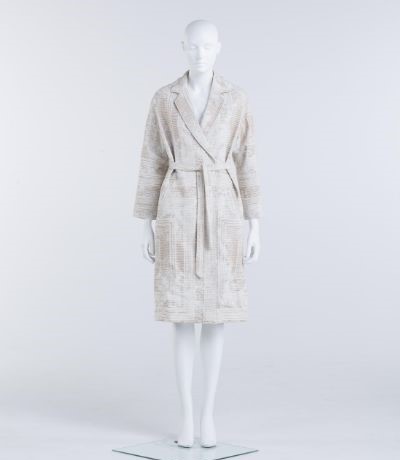Acrylic fabric is a synthetic material known for its softness and warmth. It is made from a synthetic polymer called acrylonitrile, derived from petroleum or coal-based chemicals.
| Fiber Source | Synthetic, derived from coal or petroleum-based chemicals |
| Weaving Patterns | Various, including knits and weaves |
| Dominant Colors | Wide range, holds color well, available in vibrant hues |
| Texture Spectrum | Soft, lightweight, can mimic wool or cashmere |
| Breathability Index | Low, not highly breathable |
| Strength & Longevity | Durable, resistant to mildew, mold, moths, and chemicals |
| Maintenance Needs | Machine washable, prone to pilling, heat sensitive |
| Primary Applications | Sweaters, socks, fleece wear, hats, outdoor gear |
| Ecological Impact | Not environmentally friendly, releases microplastics |
| Major Exporters | Global production, no specific dominant regions |
| Comparable Fabrics | Polyester, Nylon |
The production of acrylic fabric involves extruding the polymer through a spinneret to form fibers, which are then spun into yarns and woven into fabric.
1. Properties and Applications
Acrylic fabric closely resembles wool in terms of look and feel. It is lightweight, soft to the touch, and provides significant warmth, making it a popular wool substitute or blend component. Comfort properties of acrylic and its blends highlight their varying water vapor permeability and wicking abilities.
Innovative dyeing techniques using microbial pigments offer environmentally friendly alternatives for acrylic fabrics. This method, utilizing non-toxic natural pigments, not only provides rich coloration but also imparts antibacterial properties, marking a significant advancement in textile processing
This fabric is primarily used in clothing like sweatshirts, hoodies, jackets, and athletic wear due to its durability and warmth. Additionally, its application extends to furniture, particularly outdoor and less expensive types, due to its rougher texture compared to plant-based textiles. Acrylic is also used in items like hair extensions, wigs, area rugs, and hairbrushes.
This black leather bomber style jacket worn by Gil Scott-Heron, was made using leather, polyester, acrylic, and wool with metal closures.
This cream-colored deep V duster jacket was designed by Billy Reid, using cotton, acrylic and polyester.
2. Comparisons with Other Fabrics
While both acrylic and polyester are synthetic and petroleum-based, they have different properties. Acrylic is less durable than polyester, more prone to pilling, and shrinks more easily. However, it is warmer, making it suitable for cold-weather clothing. Polyester offers more flexibility and a variety of uses.
Acrylic provides more insulation and warmth compared to cotton, but lacks cotton’s softness, breathability, and moisture absorbency. Cotton is more comfortable in warm temperatures and is a natural, plant-grown substance.
3. Environmental and Health Impacts
Acrylic fabric’s environmental impact is significant, mainly because it is not biodegradable. Its production processes can be harmful to workers and surrounding ecosystems, with risks of pollution and toxic waste. A significant study on microfiber pollution underscores the environmental challenges posed by synthetic textiles like acrylic. It examines the release of microfibers during laundering, a crucial factor in assessing the ecological footprint of synthetic fabrics
A study demonstrates reusing acrylic fabric waste to produce activated carbon fabric with high adsorption capacities, a promising step towards eco-friendly textile solutions. Plasma treatments for acrylic fabrics reveals promising alternatives for traditional textile finishing processes. These treatments can impart special properties like waterproofing and oil repellence, with minimal environmental impact
Acrylic fabric can be problematic for sensitive skin and has been a topic of debate regarding its potential carcinogenic properties. The chemicals used in its production and dyeing, including formaldehyde, raise concerns about health risks.
4. Acrylic Fabric Variants
- Normal Acrylic: Contains at least 85% acrylonitrile.
- Modacrylic: Includes a mix of acrylonitrile and other polymers, offering better drapability and flame resistance.
- Nytril: Primarily composed of vinylidene dinitrile, not widely popular or produced in large quantities.
- Lastrile: An elastic form of acrylic used in applications where more elasticity is desired.
Modacrylic offers several advantages over standard acrylic, such as better resistance to pilling, abrasion, and maintaining shape. It is also flame-resistant, unlike normal acrylic, which is highly flammable.
5. Care and Maintenance
Acrylic fabric requires careful washing, preferably in warm water, to maintain its durability and flexibility. It can stain easily, necessitating the use of stain-resistant chemicals. Acrylic fabric grafting with acrylic acid reveals potential for enhancing antibacterial properties, suggesting a novel approach to improving fabric functionality while maintaining its inherent qualities
6. Conclusion
Acrylic fabric stands out for its warmth, softness, and versatility in various applications. However, its environmental and health impacts, along with its comparison with other fabrics like polyester and cotton, should be considered when choosing this material for specific uses.


